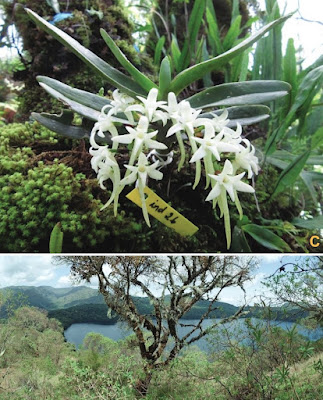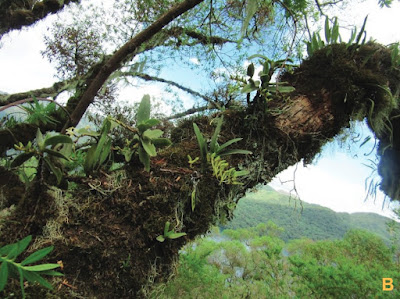Abstract
Background and aims – A recent taxonomic and molecular study of the genus Cyrtorchis revealed three new species. Here, we describe one of these new species, endemic to the Cameroon Volcanic Line (CVL), and compare it to its closest relatives. Its conservation status is provided along with detailed information on its ecology and reproductive biology.
Material and methods – A detailed examination of 21 herbarium specimens was performed using standard practices of herbarium taxonomy. The conservation status of the new species was assessed using the IUCN Red List Categories and Criteria. Furthermore, we investigated the reproductive biology of the new species in an easily accessible subpopulation in Cameroon and tested the hypothesis of hawkmoth pollination in the genus Cyrtorchis.
Key results – The newly discovered species, here named C. okuensis, is restricted to the montane forest (1600 to 2500 m elevation) of the CVL and is currently assessed as Near Threatened (NT). Among angraecoid orchids in which hawkmoth pollination is recorded (~16 species), C. okuensis has the shortest nectar spur (19–40 mm). In situ observations revealed hawkmoths with short proboscis of the genus Hippotion (H. celerio, H. eson, and H. osiris) as the main pollinators. The rate of pollination and fruiting under natural conditions was low and among the 448 surveyed flowers only 38.8% (174/448 flowers) had their pollinia removed, 19% produced fruits (87/448 flowers), and 16% (70/448 flowers) set mature fruits.
Conclusion – Cyrtorchis okuensis is clearly differentiated from C. submontana by its longer and wider floral bracts, longer anther caps, and wider triangular dorsal sepal.
Keywords: angraecoid orchids, epiphyte, hawkmoth, IUCN Red List Categories and Criteria, pollination, systematics
 |
| Cyrtorchis okuensis in its natural habitat, the shrubby savannah around the volcanic lake Oku. A. Panoramic view of C. okuensis habitat in the survey area. |
Cyrtorchis okuensis Droissart, Azandi & M.Simo, sp. nov.
– Cyrtorchis aff. guillaumetii “Oku” (Azandi et al. 2021).
Diagnosis – Cyrtorchis okuensisis similar to C. submontana but differs in having wider floral bracts (7–12.5 × 8–13.7 mm vs 4–6.5 × 5–7 mm), longer anther caps (2.5–3 vs 1–2 mm), and wider triangular dorsal sepal (4–5 mm vs 2–3 mm). These species also differ by their habitat; C. submontana is found in submontane and evergreen moist forest (between 550 and 1,200 m), whereas C. okuensis is restricted to the upper montane vegetation (between 1,600 and 2,500 m) along the Cameroon Volcanic Line.
Distribution – Endemic to the Cameroon Volcanic Line: Nigeria, Cameroon, and Bioko (Equatorial Guinea) (fig. 3).
Habitat and ecology – Restricted to montane vegetation (moist forest, forest-grassland edge, and wooded savannah from 1,600 to 2,500 m), Cyrtorchis okuensis grows on mossy branches of Gnidia glauca (Fresen.) Gilg (Thymelaeaceae), Albizia gummifera (J.F.Gmel.) C.A.Sm. (Fabaceae), and Prunus africana (Hook.f.) Kalkman (Rosaceae). On these phorophytes, C. okuensis is usually found growing with mosses, lichens, ferns, and other orchid species (see details below in “Ecology and reproductive biology”).
Etymology – The epithet okuensis refers to Oku, a subdivision in the North-West Region of Cameroon where the large, surveyed subpopulation was discovered around Lake Oku. The term Oku also refers to the people who live in this area and their native language.
Laura N. Azandi, Tariq Stévart, Bonaventure Sonké, Murielle Simo-Droissart, Tania D’haijère and Vincent Droissart. 2021. Taxonomic Description and Pollination Ecology of Cyrtorchis okuensis (Orchidaceae, Angraecinae), A New Species Endemic to the Cameroon Volcanic Line. Plant Ecology and Evolution. 154(3); 483-496. DOI: 10.5091/plecevo.2021.1823







